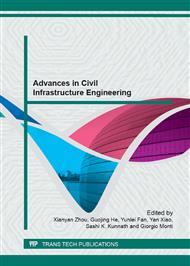p.1114
p.1120
p.1127
p.1133
p.1137
p.1142
p.1148
p.1155
p.1162
Development of a Remotely Collaborative Testing Platform for Bridge Structures Based on NetSLab
Abstract:
A remotely collaborative pseudo-dynamic testing platform for bridge structures has been developed based on NetSLab system. It can be used for seismic performance investigation of large-scale bridge structures by combining the Internet and sub-structure technology. The testing platform consists of three modules: control center, physical tester and virtual tester. Through a network communication platform, the operation of receiving and feedback of test data between various modules can be realized. Based on the previous research work, a further improvement of the dynamic structural model, the finite element numerical analysis and the rational division of sub-structure has been achieved. A series of remotely virtual collaborative pseudo-dynamic test of bridge structures has been conducted to verify the feasibility of the test platform.
Info:
Periodical:
Pages:
1137-1141
Citation:
Online since:
January 2013
Authors:
Price:
Сopyright:
© 2013 Trans Tech Publications Ltd. All Rights Reserved
Share:
Citation:


